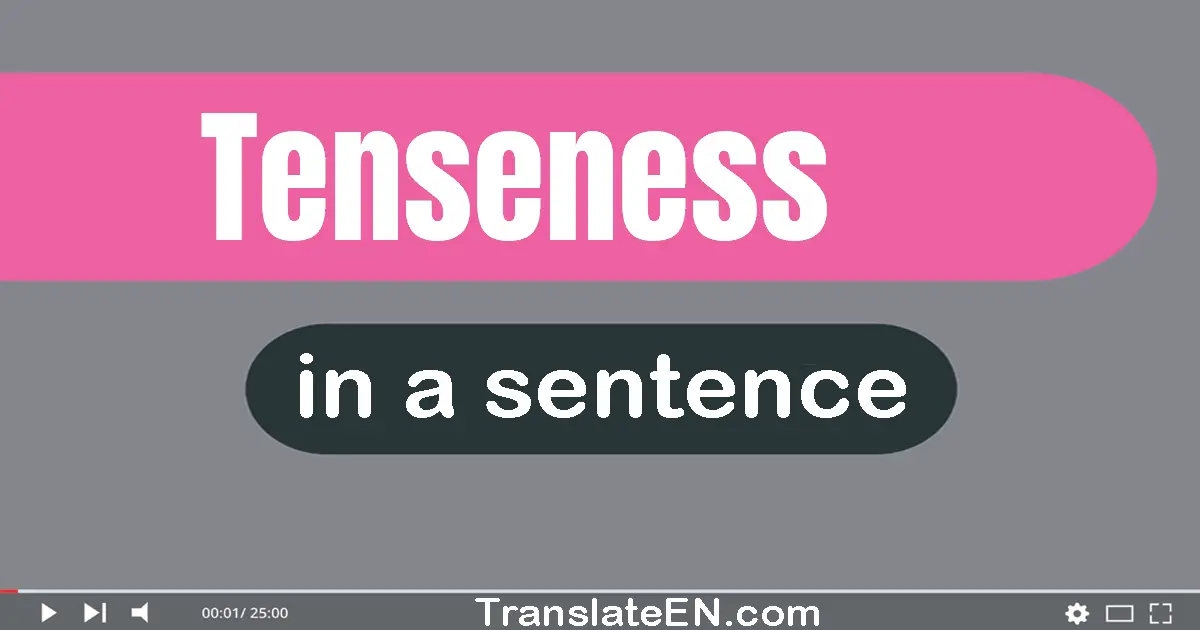Tenseness in a sentence
Synonym: tightness, strain. Antonym: relaxation, looseness
Meaning: The state of being tense or tight.

(1) The tenseness in his jaw indicated his anger.
(2) The tenseness in his voice indicated his fear.
(3) The tenseness in her voice revealed her anxiety.
(4) The tenseness in his shoulders showed his stress.
(5) The tenseness in her body showed her anticipation.
(6) The tenseness in her face showed her determination.
(7) The tenseness in her voice revealed her frustration.
(8) The tenseness in her voice betrayed her nervousness.
(9) The tenseness in the air was broken by a sigh of relief.
(10) The tenseness in the air was broken by a burst of laughter.
Tenseness sentence
(11) The tenseness in the room was broken by a burst of applause.
(12) The tenseness in the room was broken by a moment of silence.
(13) The tenseness in the room was broken by a round of applause.
(14) The silence was broken only by the sound of their tenseness.
(15) The tenseness in her shoulders showed the stress she was under.
(16) The tenseness in the courtroom was broken by a sudden outburst.
(17) The tenseness in his body was evident as he clenched his fists.
(18) The tenseness in his body was evident as he paced back and forth.
(19) The tenseness in his muscles showed that he was ready for action.
(20) The tenseness in the crowd grew as the concert was about to begin.
Tenseness make sentence
(21) The tenseness in the atmosphere was broken by a burst of laughter.
(22) The tenseness in the room dissipated as they reached a compromise.
(23) The tenseness in the air was broken by a sudden burst of laughter.
(24) The tenseness in the air was broken by a collective sigh of relief.
(25) The tenseness in the room was palpable as the two rivals faced off.
(26) The tenseness in his jaw showed that he was holding back his anger.
(27) The tenseness in the air was broken by a sudden burst of excitement.
(28) The atmosphere was filled with tenseness as the two rivals faced off.
(29) She tried to hide her tenseness, but her shaking hands gave her away.
(30) The tenseness in his voice indicated his frustration with the situation.
Sentence of tenseness
(31) She could feel the tenseness in her muscles as she prepared for the race.
(32) The room was filled with a sense of tenseness as the deadline approached.
(33) The tenseness in the room dissipated as soon as the problem was resolved.
(34) The tenseness in the atmosphere was broken by a sudden burst of laughter.
(35) The tenseness in the room dissipated as soon as the conflict was resolved.
(36) The tenseness in the atmosphere was so thick you could cut it with a knife.
(37) The tenseness in the conversation was evident as they argued back and forth.
(38) The tenseness in the room was palpable as everyone awaited the final results.
(39) The tenseness in their conversation was evident as they spoke in hushed tones.
(40) The tenseness in her body language indicated that she was uncomfortable with the situation.
Tenseness meaning
Tenseness is a word that describes a state of being tense or filled with tension. It can be used to convey a variety of emotions or situations, ranging from anxiety and stress to anticipation and excitement. To effectively use the word "tenseness" in a sentence, consider the following tips:
1. Contextualize the word: When using the word "tenseness," it is important to provide enough context for the reader to understand the specific situation or emotion being described. This will help create a clear image in the reader's mind and enhance the overall impact of your sentence. Example: The tenseness in the room was palpable as the two rival teams prepared to face off in the championship match.
2. Use descriptive language: To paint a vivid picture, incorporate descriptive language that further emphasizes the feeling of tenseness. This can include adjectives, adverbs, or even metaphors that enhance the overall imagery of the sentence. Example: The air was thick with tenseness as the protagonist cautiously stepped into the dimly lit, eerie hallway.
3. Consider the tone: Depending on the context, the word "tenseness" can be used to convey different tones. It can be used to describe a negative or uncomfortable situation, but it can also be used to depict a thrilling or suspenseful moment. Adjust the tone of your sentence accordingly to accurately reflect the intended meaning. Example (negative tone): The tenseness in her voice was evident as she recounted the traumatic experience. Example (suspenseful tone): The movie built up a sense of tenseness, leaving the audience on the edge of their seats.
4. Show, don't tell: Instead of simply stating that there is tenseness, try to show it through actions, dialogue, or other sensory details. This will make your sentence more engaging and allow the reader to experience the tenseness themselves. Example: The silence was broken by the sound of a cracking twig, causing a wave of tenseness to wash over the group of hikers.
5. Vary sentence structure: To keep your writing engaging, vary the structure of your sentences when using the word "tenseness." This can include using different sentence lengths, incorporating clauses, or experimenting with punctuation to create a rhythmic flow. Example: With each passing second, the tenseness grew, suffocating the room and leaving everyone on edge.
In conclusion, when using the word "tenseness" in a sentence, it is important to provide context, use descriptive language, consider the tone, show rather than tell, and vary sentence structure. By following these tips, you can effectively convey the meaning and impact of tenseness in your writing.
The word usage examples above have been gathered from various sources to reflect current and historical usage of the word Tenseness. They do not represent the opinions of TranslateEN.com.
